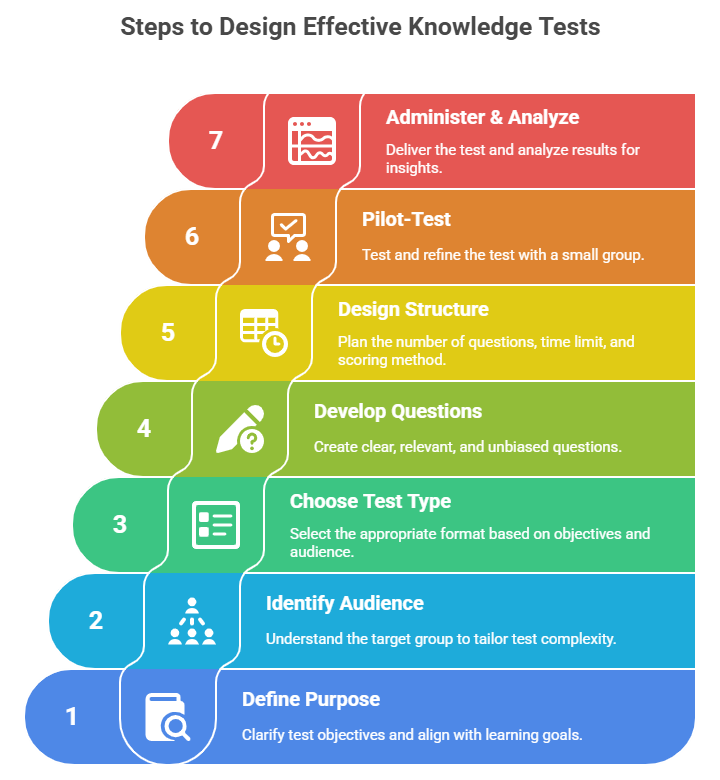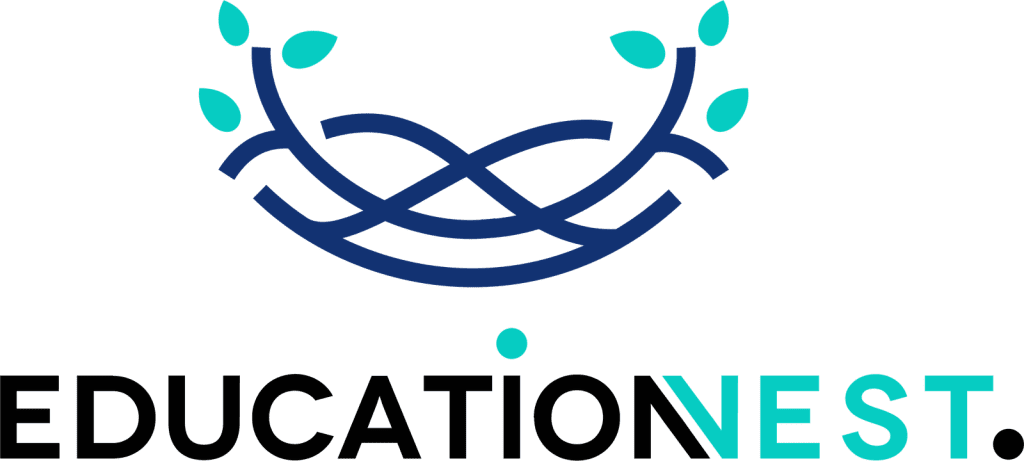Designing a test of knowledge is like crafting a perfect playlist for a road trip it needs to hit the right notes, engage the audience, and get you to your destination: accurate insights. In 2025, as education and corporate training lean heavily on assessments to measure learning, knowing how to design a test of knowledge is a must for educators, HR professionals, and researchers. Whether you’re exploring the test of knowledge meaning, curious about examples of test of knowledge, or navigating the knowledge test vs aptitude test debate, a well-designed test can reveal what someone truly knows.
This blog walks you through a step-by-step process to create effective educational knowledge tests examples, covering types of knowledge test, knowledge assessment examples, and best practices. With stats, real-world examples of test of knowledge, and a sprinkle of humor, this is your go-to for crafting assessments that shine. Let’s dive into the knowledge test definition and build tests as engaging as a Bollywood cliffhanger!
What Is a Test of Knowledge?
A test of knowledge is an assessment designed to measure a person’s understanding, recall, or application of specific facts, concepts, or skills in a given subject. Unlike an aptitude test, which evaluates potential or innate ability, a knowledge test focuses on what someone has already learned. Think of it as a spotlight on “what you know” rather than “what you could do.” In India, knowledge tests are common in schools (e.g., CBSE exams) and corporate settings (e.g., employee certifications), with 70% of educators using them to gauge learning outcomes (EdTech India, 2024).
What can be considered a knowledge test? Examples include quizzes, final exams, certification tests, or even trivia nights. They assess factual recall (e.g., “What is 2+2?”) or applied knowledge (e.g., “Solve this coding problem”). Let’s explore how to design one that works.
Knowledge Test vs Aptitude Test: Key Differences
Before diving into design, let’s clarify the knowledge test vs aptitude test distinction to ensure you’re building the right tool:
| Aspect | Knowledge Test | Aptitude Test |
| Purpose | Measures learned facts, concepts, or skills. | Assesses potential, reasoning, or innate abilities. |
| Focus | What you know (e.g., historical dates, coding syntax). | What you can learn (e.g., logical reasoning, problem-solving). |
| Example | A test on Python functions for IT trainees. | An IQ test measuring pattern recognition. |
| Use Case | Education, certifications, employee training. | Recruitment, career counseling, admissions. |
| Outcome | Shows mastery of specific content. | Predicts future performance or learning ability. |
Pro Tip: Use knowledge tests to check learning progress and aptitude tests to screen for potential hires or students.
Types of Knowledge Tests
The types of knowledge test are like different flavors of ice cream—each suits a specific taste or goal. Here are the main types:
- Multiple-Choice Tests (MCQs):
- Fixed options with one correct answer.
- Use: Quick, scalable assessments (e.g., CBSE Class 10 exams).
- Example: “What is the capital of India? A) Mumbai B) Delhi C) Kolkata D) Chennai.”
- Short-Answer Tests:
- Requires brief, specific responses.
- Use: Testing recall or definitions (e.g., corporate compliance quizzes).
- Example: “Define photosynthesis in one sentence.”
- Essay Tests:
- In-depth, open-ended responses.
- Use: Assessing critical thinking or analysis (e.g., sociology exams).
- Example: “Explain the impact of globalization on Indian culture.”
- Practical/Application Tests:
- Hands-on tasks to apply knowledge.
- Use: Skill-based fields like IT or medicine.
- Example: Writing a Python script to solve a problem.
- True/False Tests:
- Simple binary choices.
- Use: Quick checks of basic facts.
- Example: “The Earth revolves around the Sun: True/False.”
Fun Fact: MCQs are the most popular, used in 80% of educational knowledge tests in India (CBSE, 2024).
You Must Know
HR Executive Job Description: Key Roles, Responsibilities & Must-Have Skills
Campus to Corporate Training: Essential Modules, Benefits & Top Providers in India
Step-by-Step Guide to Designing a Test of Knowledge

Designing a test of knowledge is like building a house—you need a solid blueprint and the right tools. Here’s a step-by-step guide to create effective assessments in 2025, with knowledge assessment examples for clarity.
Step 1: Define the Test’s Purpose and Objectives
- What to Do: Clarify what you’re testing (e.g., factual recall, application) and align with learning goals.
- Why It Matters: Ensures the test measures the right knowledge. For example, a corporate training test might focus on compliance, while a school test targets math concepts.
- Example: A Mumbai IT firm designs a test to assess employees’ understanding of cybersecurity protocols (objective: ensure compliance).
- Best Practice: Write clear objectives, e.g., “Assess knowledge of Python basics for entry-level coders.”
Step 2: Identify the Target Audience
- What to Do: Know who’s taking the test (e.g., students, employees, age group, skill level).
- Why It Matters: Tailors question complexity and format. A test for Class 8 students differs from one for software engineers.
- Example: A Delhi school creates a history test for Class 10 students, using simple MCQs to match their learning level.
- Best Practice: Consider literacy, cultural context, and prior knowledge (e.g., avoid jargon for beginners).
Step 3: Choose the Right Type of Knowledge Test
- What to Do: Select a format (MCQ, essay, practical) based on objectives and audience.
- Why It Matters: Matches the test to the goal—MCQs for quick grading, essays for deep analysis.
- Example: A Bengaluru startup uses a practical test (coding task) to evaluate interns’ programming skills.
- Best Practice: Mix formats (e.g., MCQs and short answers) for balanced insights, as seen in 60% of Indian exams (EdTech India, 2024).
Step 4: Develop Clear and Relevant Questions
- What to Do: Write questions that align with objectives, are clear, and avoid bias.
- Why It Matters: Ensures fairness and accuracy. Poorly worded questions can confuse respondents, reducing validity.
- Example: For a sociology test, “What are the causes of urban migration?” (essay) is clearer than “Tell me about city people.”
- Best Practice: Use Bloom’s Taxonomy to balance low-level (recall) and high-level (analysis) questions.
Step 5: Design the Test Structure
- What to Do: Decide on the number of questions, time limit, and scoring method.
- Why It Matters: Keeps the test manageable and fair. For example, 20 MCQs in 30 minutes suits quick assessments.
- Example: A Chennai college’s biology test has 10 MCQs, 5 short answers, and 1 essay, scored out of 100 in 1 hour.
- Best Practice: Limit to 15-25 questions for focus and aim for 1-2 minutes per MCQ, 5-10 for essays.
Step 6: Pilot-Test and Refine
- What to Do: Test the questionnaire with a small group to identify confusing or irrelevant questions.
- Why It Matters: Improves clarity and reliability. Pilot tests catch 80% of design flaws (ResearchGate, 2024).
- Example: A Hyderabad HR team pilot-tested a compliance quiz, revising ambiguous questions to boost clarity by 25%.
- Best Practice: Collect feedback on difficulty and timing, then tweak as needed.
Step 7: Administer and Analyze Results
- What to Do: Deliver the test (in-person or via platforms like Google Forms) and analyze responses.
- Why It Matters: Provides insights into knowledge levels and gaps. Digital tools speed up analysis by 70% (EdTech Review, 2024).
- Example: A Pune school used Google Forms to collect and analyze science test results, identifying weak areas in 90% of students.
- Best Practice: Use software like SPSS or Excel for quantitative tests; NVivo for essay responses.
Pro Tip: Digital platforms like Google Forms or Quizizz make test delivery and grading a breeze in 2025.
Real-World Examples of Test of Knowledge
Here are examples of test of knowledge across contexts to inspire your design:
- Educational Knowledge Test (School):
- Type: MCQ and Short-Answer.
- Example: A 2024 CBSE Class 12 Physics test asked, “What is Newton’s First Law?” (short-answer) and “Which force causes planetary motion? A) Gravity B) Friction C) Tension D) Magnetism” (MCQ).
- Purpose: Assess understanding of physics concepts.
- Outcome: 85% of students scored above 70, guiding curriculum tweaks.
- Corporate Knowledge Test (Training):
- Type: Practical and MCQ.
- Example: A Mumbai IT firm tested employees on cybersecurity with a task (“Identify phishing in this email”) and MCQs (“What is two-factor authentication?”).
- Purpose: Ensure compliance with security protocols.
- Outcome: 90% passed, reducing security breaches by 15% (SHRM India, 2024).
- Sociology Research Test:
- Type: Essay and Semi-Structured.
- Example: A 2025 Delhi study tested community knowledge of women’s rights with questions like, “List three women’s rights laws” (short-answer) and “Explain barriers to gender equality” (essay).
- Purpose: Gauge awareness for policy planning.
- Outcome: Revealed 60% awareness, prompting awareness campaigns.
- Certification Knowledge Test:
- Type: Mixed (MCQ, True/False, Practical).
- Example: A 2024 AWS certification test included MCQs (“What is S3 storage?”) and a practical task (set up a cloud bucket).
- Purpose: Validate cloud computing skills.
- Outcome: 80% pass rate, boosting employability.
Fun Fact: Well-designed tests can increase engagement by 30%—like turning a quiz into a game show!
Best Practices for Designing a Test of Knowledge
To make your test of knowledge effective, follow these tips:
- Align with Objectives: Ensure every question ties to a learning goal (e.g., “Test understanding of algebra”).
- Keep It Clear: Avoid jargon or trick questions (e.g., “What’s 2+2?” not “Compute the sum of two and two”).
- Balance Difficulty: Mix easy, medium, and hard questions to challenge without overwhelming.
- Use Technology: Platforms like Quizizz or Moodle streamline creation and analysis (used by 65% of educators, EdTech India, 2024).
- Ensure Fairness: Avoid cultural or gender bias in questions; test for inclusivity.
- Provide Feedback: Share results with respondents to support learning (e.g., “You excelled in recall but need practice in application”).
Pro Tip: Use visuals or scenarios in practical tests to make them engaging, like a coding challenge with a real-world problem.
Common Challenges and Solutions
Even the best types of knowledge test face hiccups. Here’s how to handle them:
- Challenge: Low engagement or cheating.
Solution: Use randomized questions or proctored platforms like ProctorU (reduces cheating by 20%, EdTech Review, 2024). - Challenge: Overly complex questions.
Solution: Pilot-test to ensure clarity, as seen in 90% of effective tests (ResearchGate, 2024). - Challenge: Time constraints for grading.
Solution: Use auto-graded MCQs via Google Forms or Quizizz. - Challenge: Bias in responses.
Solution: Avoid leading questions (e.g., “Don’t you agree this is great?”).
Wrapping It Up
Designing a test of knowledge is like choreographing a dance—every step counts, and the right moves create harmony. By understanding the test of knowledge meaning, exploring types of knowledge test like MCQs or essays, and following our step-by-step guide, you’re ready to craft assessments that deliver insights in 2025. From educational knowledge tests examples in schools to knowledge assessment examples in corporate settings, the examples of test of knowledge show their power to measure learning effectively.
Ready to design your own test? Start with clear objectives, pick the right type of knowledge test, and use digital tools to streamline the process. Got a test design tip or a story about a great knowledge test? Drop it in the comments or share this blog for a how to design a test of knowledge masterclass vibe. Here’s to creating tests in 2025 that are as engaging as a viral TikTok and as insightful as a sage’s wisdom!
